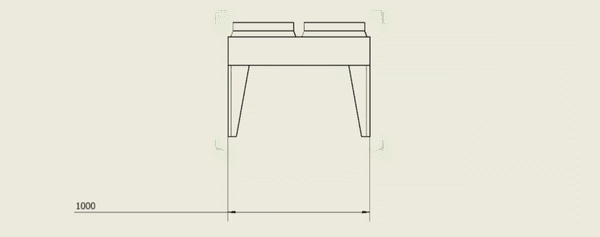-
Automating Batch Exports for Modern Manufacturing
Streamlining CNC Workflow with Automated File Exports In modern manufacturing, automating batch exports is essential for improving efficiency, reducing errors, and optimising workflows. Computer Numerical Control (CNC) machines rely on digital files like DXF (Drawing Exchange Format) and STEP (Standard for the Exchange of Product Data) for precision machining. While this digital process enhances accuracy…

-
Programmatic CAD: Faster Furniture Production
In today’s fast-paced manufacturing and engineering landscape, speed and adaptability are crucial. Programmatic design and parametric CAD modeling enable engineers and designers to respond quickly to changing requirements without sacrificing quality. Rather than manually creating multiple variants of a product from scratch, programmatic approaches leverage parametric modelling, automation tools, and custom logic to generate countless…

-
Using Different Model States in Autodesk Inventor
In design engineering, managing components or assemblies in multiple configurations is crucial for creating adaptable and efficient designs. Take, for example, a door hinge. It may need to be displayed in open and closed positions within different assemblies or in the same assembly at various times. Handling these variations effectively ensures streamlined workflows and consistency…

-
Selecting Start, Mid, and End Points on a Line in Inventor
When adding annotations to drawings in Autodesk Inventor, it’s often useful to select specific points along the edges of objects, such as the start, midpoint, or endpoint of a line, similar to how you would when adding dimensions. Inventor’s API provides access to this selection system through the PointInferenceEnabled property. By setting this property to…

-
Creating a custom user interface
Revolutionizing Autodesk Inventor with a bespoke user interface, our solution accelerates the design process. Delve into our journey of crafting a custom interface tailored for speed, transforming heat exchanger circuit design. What is a custom user interface? A custom user interface is a tailored method enabling users to interact with a system in a manner…

-
Speed optimisations for searching iPart variants
Using iParts in Inventor makes it quick and easy to create hundreds of part variants. When working with Inventor’s API, it also simplifies locating the correct part since you only need to know the location of the factory file and search within for the variants, rather than finding the exact part file. However, searching for…
-
Creating geometry from scratch using Inventors API
-
Automating Dimension Placement in Inventor Drawings
When working with multiple variants of a part, creating drawings for each variation can be tedious and repetitive. By cleverly using Inventor’s attribute system in conjunction with custom code, it is possible to fully automate the creation of drawings. In the following example, we will focus on placing dimensions, as these are often the most…

-
Fixing Attribute Helper for Inventor 2024
What is attribute helper Attribute helper is a tool that comes with Inventor that allows you to visualize, create, and edit attributes on a document. How to install attribute helper What broke Issues with COM Object Handling: After releasing a COM object, it is common practice to set the variable to nothing to prevent any…

-
Placing objects in Autodesk Inventor using the API
Automating the placement of objects in Autodesk Inventor assemblies can significantly enhance efficiency in design workflows. This guide delves into using the Inventor API to position and orient parts within an assembly, focusing on the manipulation of matrices for precise control. Establishing a Connection to Inventor Begin by obtaining a reference to the active Inventor…

-
Exporting Images of Autodesk Inventor Files
Introduction Exporting images of Autodesk Inventor files is a valuable process, especially when applying changes to multiple files. It allows for quick verification of outputs without the need to fully open each file, saving significant time and resources. This guide explores two methods for exporting images from Inventor files, their respective advantages and time efficiencies,…
-
Automating data entry into Autodesk Inventor with Excel
In the world of CAD and design, efficiency and accuracy are paramount. Automation in Autodesk Inventor using Excel data can significantly streamline workflows, particularly in repetitive tasks like data entry. This guide provides a detailed explanation of how to automate the process of inputting data into Inventor using a sample C# or VB code script.…
-
Replacing drawing title block
Replacing the drawing title block in Autodesk Inventor with a single click. Using Inventors API its possible to replace the block on an old drawing in a fraction of a second, simply by copying the block from the current template and pasting it onto the old drawing. Why replace the title block? When everything is…
-
Connecting Visual Studio to other applications
When collaborating with other applications and libraries, it’s essential to instruct your Integrated Development Environment (IDE), such as Visual Studio, where to locate the required files. This action enables the IDE to recognize available objects, providing programming support, and allows it to reference the files during code compilation. To include a reference in your project,…
-
Export all iPart variants
To generate the render featured on the Tabulated designs with iPart page, I had to create and export all the members of the iPart. To save myself from a monotonous and repetitive task, I developed a small macro to handle the file exports instead. The process is straightforward. Firstly, obtain a reference to the part…

-
Tabulated designs with iPart
Inventor offers the capability for a single part or assembly to manage numerous variants. Using iPart and iAssembly, you can create a master file that, upon request, generates a part for the desired variant. Each variant maintains a link to the master, enabling simultaneous changes across all associated parts. How to create an iPart Start…











